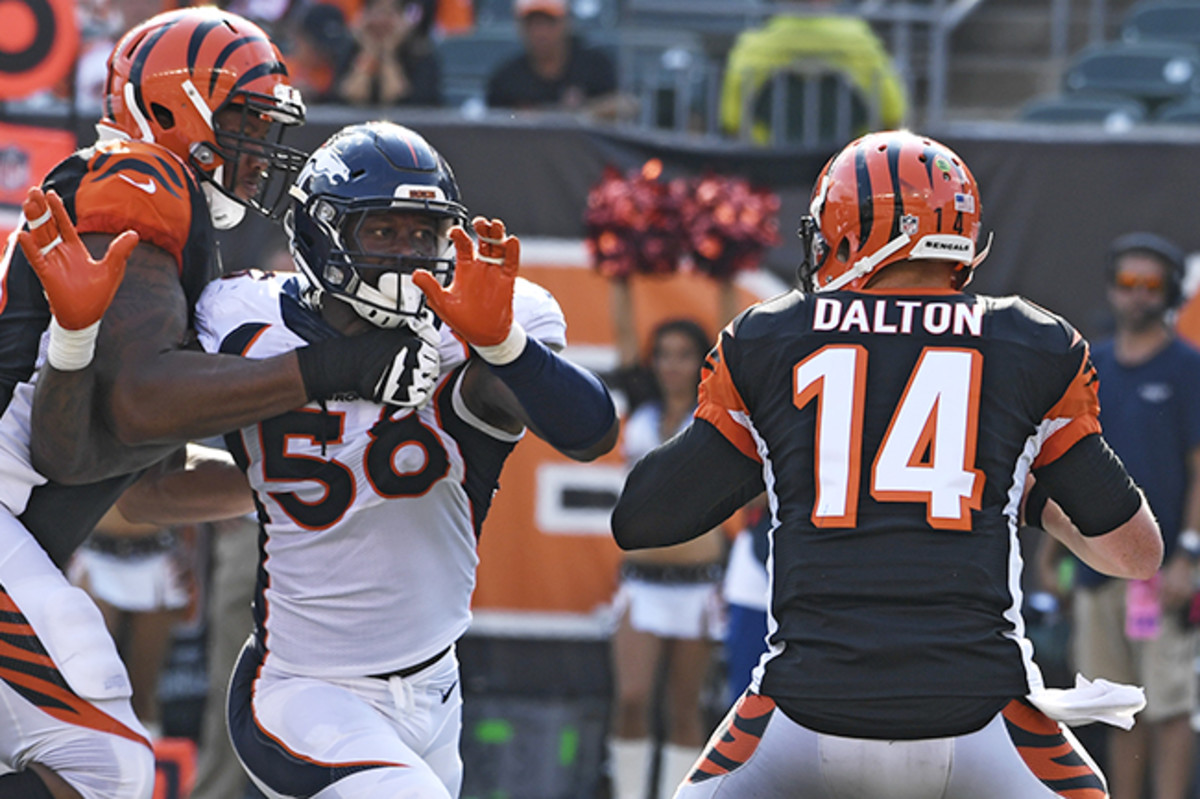Death of the Blind Side, and Rise of the Plain-Sight Pass Rush

Eleven years ago, Michael Lewis, the smartest writer in America, wrote perhaps the smartest football book of its generation: The Blind Side: Evolution of a Game. Through the story of Michael Oher, Lewis argued that left tackle was a football team’s second most important player because of the way he protected its most important player, the quarterback. This became conventional wisdom, and since 2004 left tackle has been the second-highest-paid position in football.
But with football’s constant evolution, conventional wisdom inevitably reaches the point of becoming flawed. The question is: When it comes to the blind side, have we reached that point?
In the current NFL landscape, the overwhelming majority of top pass rushers play left defensive end or linebacker, which means they line up across from the right tackle. That includes J.J. Watt, Von Miller, Khalil Mack, Justin Houston, Joey Bosa, Vic Beasley, Cameron Wake, Cliff Avril, Markus Golden, Ryan Kerrigan, Carlos Dunlap, Cameron Jordan, Jason Pierre-Paul and Danielle Hunter, a 22-year-old rising star who recorded 12.5 sacks for the Vikings last year.
Starting right tackles, on average, make barely half of what left tackles make. Yet, based on the defenders they face, you could argue that right tackles are more important. Not only are the top sack-producers coming from the offense’s right side, but so are the turnover-creators. Many of these left defensive ends are the leaders in sack-fumbles. Cliff Avril sets the bar there. Before him, it was now-retired longtime Colts edge rusher Robert Mathis, who lined up primarily on the left side.
This makes perfect sense. Most quarterbacks are righthanded. When you rush the QB from his right side, you’re closer to the ball. Picture a pass rusher: He dips low around the corner, with his helmet at about the height of the quarterback’s shoulder. This, by the way, naturally puts the defender out of the quarterback’s line of vision. Maybe he’s not completely in the QB’s blind spot, but he’s in an uncomfortable part of the QB’s periphery, which brings us to the next danger posed by a pass rusher coming off the offense’s right side.

A quarterback who sees a pass rusher coming can brace for the hit, not preferable for a defender getting that sack. But when the QB has a pass rusher in his line of vision, he might also brace for a hit that is not imminent. That, in and of itself, can be enough to ruin a play. The primary goal of a pass rush isn’t to hit the quarterback (though that’s always a plus), it’s to force the quarterback to play on your schedule, not his. A quarterback who sees a pass rusher coming almost always will operate on the defense’s schedule. If he’s a good quarterback, he’ll check the ball down early. If he’s a bad quarterback, he’ll panic and break down his own pocket.
Though no defensive coach or player would ever admit it in these terms, the beauty of a blind-side hit is that it’s more likely to injure the quarterback. But how often does that actually happen? How many instances can you remember when a QB dropped back, got drilled blindly from the left side and was out of the game? Any hit can knock out a quarterback. In fact, if you hit a quarterback from his right side, you’re more likely to impact the arm, hand or shoulder he throws with. Plus, with shotgun now the formation of choice, the quarterback’s vision cone is bigger, making the blind side a little less blind anyway.
Of course, there’s also a chicken-and-egg conversation to be had. Are more sacks coming from the offense’s right side because offenses habitually put their less talented tackle over there? And is the opportunity to exploit a less talented blocker why defenses are putting their best pass rushers on that side? Perhaps.
* * *
* * *
But let’s go back to the original thinking of the blind-side tackle. Another reason it became valuable is the left is usually considered to be the weak side. In other words, the side away from where the tight end aligns. The thinking is that, with QBs being righthanded, tight ends most often line up on the right side. Which means right tackles have a help-blocker while left tackles are all alone.
But, in actuality, this is no longer the case. With more spread offenses, tight ends are lining up on the line of scrimmage less often. And with the preponderance of quick-strike throws, the immediate spacing of the formation becomes more significant. The strength of your formation is not usually determined by right and left, but rather, by where the ball is spotted. If it’s on the left hashmark, your formation is likely to have more bodies on the right, where there’s more field space. If the ball is on the right hash, there’s more field space to the left. The strength of the formation is likely to go there.
This means left and right tackles are equally likely to face one-on-one pass-blocking scenarios. The difference is that when a right tackle is in one-on-one, he’s more likely to be up against an elite pass rusher. Defensive coaches don’t care who is at left or right tackle—they care about which of those two players is weaker. That’s what they’ll center their pass rush concepts around. And it’s how an offensive coach will build his protections.
As the game continues down its current path, the two tackle positions will balance out. We’ll soon see right tackles valued equally to left tackles. It’s just taking a little longer than it should to throw this latest bit of conventional wisdom out the window.
Question or comment? Email us at talkback@themmqb.com.
